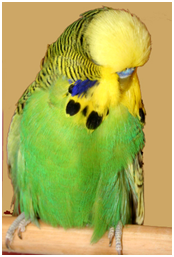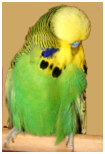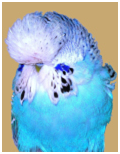The Ideal – Part 2
The Big Issue: Exhibition or ‘English’ Budgerigars
Visit a show in the UK today and you will see birds like the one below being awarded trophies as paragons of the breeder’s skill. Ironically, it has taken great skill for breeders to produce birds with these highly exaggerated characteristics: massive heads, a doubling of body size, invisible eyes, mask-spots have become hugely elongated ‘blotches’ and so on. These poor birds retain only faint traces of the elegance, grace and balance of the classic bird of the 1930’s -50’s. These ‘freaks’ are masterpieces of the breeder’s art – but they have lost all the beauty of the original birds; they are grotesquely ugly.
Take a Close Look at this ‘Champion’ Exhibition Budgerigar
The head is massively ‘out of proportion’ with the rest of the body; every other quality has been sacrificed and as a result the balance, beauty, grace and colour depth of the original species have been lost. In reality, the bird’s skull has not grown any larger – it is merely the feathers which have become larger and denser. This is most obvious in the change of the neat mask-spots into huge, elongated feathers which look more like wing-covert plumes than facial feathers. I was appalled to hear that many fanciers have special tweezers to ‘pluck’ excess mask spots and feathers from the birds faces before exhibitions – and that ‘trimming scissors’ are also frequently used.
This view will not cut much ice with fanciers who have spent decades developing these artificial creations; but arguably, they are heading down a genetic cul-de-sac. The number of UK breeders has fallen from 40,000 in the 1960’s to a mere 4,000 today; so the gene-pool has shrunk by more than 90%. Even worse – the number of champion exhibition studs has fallen to just a few dozen; and since they constantly share blood-lines and continue to in-breed, the genetic resource shrinks with each generation. New fanciers will go to the most successful champions and buy the ‘best’ stock they can afford, so they are buying into a very limited pool of closely related birds. This generates a downward spiral of genetic diversity – with the same bloodlines becoming more and more concentrated, in the hands of fewer and fewer successful breeders.
Genetic Diversity
“In the shallow end of the Gene Pool – there are no Lifeguards”
The laws of genetics apply equally for all animals – whether they be: humans, cheetahs or budgerigars. Mating with close relatives – even with first-cousins – opens up a ‘Pandora’s Box’ of genetic faults and weaknesses because in-breeding concentrates faulty genes in a narrow, shallow gene-pool; out-breeding (exogamy) reduces the chance of faulty genes ever meeting by hiding them in a much broader and deeper gene-pool. Incest has always been forbidden in human societies – and many birds – like swans, ducks, herons, hawks etc. – will drive their offspring away from the parents’ territory once they reach sexual maturity. In Europe there is generally a cultural taboo on marrying a first-cousin since even that degree of ‘in-breeding’ is more likely to produce children with congenital defects like Downsyndrome, cleft palate, blindness and so on. Queen Victoria was closely related to the Royal families of Russia, Germany, Austria and other European states – and they tended to arrange marriages between royal cousins as a way of preserving power and loyalty; unfortunately the Saxe Coburg’s and the Romanoffs shared the faulty gene which triggers haemophelia – uncontrolled bleeding – and as a result of cousin-marriage this gene became widespread among British, German and Russian royalty – a classic example of how consanguinous marriage – or in-breeding – can carry grave health defects..
When we marry people from distant populations – or from different races – the genes get shaken-up and mixed with totally unrelated genes; children from such marriages tend to be bigger, healthier, more intelligent, more athletic: – that is why America’s melting pot of Native Americans, Mexicans, English, Russians, Irish, Scots, French, Germans, Scandinavians, Italians, Poles, Asians and Africans has produced more Olympic Champions and Nobel Prize winners than any other nation on earth. Conversely, before modern transport existed, most humans lived in small, isolated communities and married near-relatives – they tended to produce children with mental and physical deficiencies. This happened in remote rural villages in Europe and America in the 19th Century Most tribal societies practice ‘exogamy’ – choosing wives from distantly related groups for this very reason.
In the natural world most birds and animals undergo very tough competition for mates in the wild-state. Male stags, goats, lions, buffalo and wolves will fight for the right to mate with females- often to the point of death; this ensures that only the strong, fit and intelligent animals pass on their genes to their offspring; ‘Nature red in tooth and claw’ means that the weak and the sick never get the chance to breed. The same laws of competition for mates hold true for birds in the wild. Some birds compete aggressively for mates and engage in ritual battles: grouse display on ‘leks’; pheasants and cockerels will fight, sometimes to the death – and every Spring you can see blackbirds, robins and sparrows fighting for territory in any garden. The battle for the right to mates and territory is often carried out by elaborate displays – such as those of the peacock or the birds of paradise – in which the females will choose to mate with the male who has the best plumage, the most extravagant display and so on. In other cases it is the bird with the best song which is chosen – but in every case it is the male who can fight and hold a large enough territory that wins the female. The practical outcome of this is that only a bird that is fit, aggressive, intelligent and energetic enough to sing, display, fight and win the territory will get to pass on his genes to the next generation – and of course such males will choose to pursue the best females.
Competition in Wild Budgerigars
Wild budgerigars in Australia fight to survive in a harsh desert-environment where they struggle to find food and water every day. Blazing sun, 40 degree temperatures and freezing nights are the norm and they have to avoid a host of predators: many species of hawks, snakes and lizards. Budgerigars live in large colonies where they struggle for dominance in the ‘pecking order’ – and they fight for the best mates, the most secure nesting holes, the best feeding and so on. Droughts can last for years and the birds are adapted to survive on brackish water that would be poisonous to domestic birds.
Wild budgerigars and parrots run the gauntlet of extreme temperatures, droughts, food and water shortages, forced-migration, predatory hawks, snakes and lizards. In addition there is competition within the colony itself, for mates, nesting holes and food.
The upshot is that few birds survive more than a few seasons; the only birds found in a wild flock will be strong, healthy, intelligent and highly adaptable – for the simple reason that the weak, the sick, the slow and the less intelligent birds are soon killed-off. In addition there are larger seasonal ‘boom and bust’ cycles where droughts or food shortages wipe-out complete wild colonies or decimate entire populations over vast regions; some parts of Australia have endured droughts of over 5 years without rain. Dr Rob Marshall notes that wild budgerigars can fly up to 500 km (250 miles) in a single day to find water or feeding grounds and their vision is so acute that they can detect rain-storms 80 km (40 miles) away when they are flying.
On the other hand there are years or decades when abundant food and water triggers population explosions that quickly re-colonize abandoned areas; migration over vast distances is the norm for wild budgerigars. There is no such thing as an unhealthy or infertile wild budgerigar – just as there is no such thing as an unhealthy wild blackbird, robin or sparrow; Nature ruthlessly culls the weak, the sick or the stupid within days. Moreover, since budgerigars migrate in huge flocks of 5-10,000 birds – the likelihood of a bird mating with a close relative is almost zero – so genetic diversity is maximised and the gene pool is refilled, stirred and refreshed in each generation.
Domesticated Birds
Contrast the above with what happens with domesticated budgerigars in the fancier’s hands. They suffer no environmental pressure: food and water are always available temperatures are always moderate; there are no forced-migration flights of 250 miles a day; there is no competition for mates or nesting holes – everything is provided and mates are chosen by the fancier. The result is that all the pressure which natural-selection exerts on the wild birds is missing; weaker birds do not die when food or water is scarce – because it never is.
Sick birds do not die because the fancier provides heated cages, medicines and veterinary care until they are well. Birds with poor fertility or parenting ability are not naturally culled because the fancier places a high value on them and foster their eggs or chicks to other birds; he may even use foster-parent ‘feeders’ chosen from more vigorous but less show-worthy stock.
The genetic result in terms of bird-health is the exact opposite of what occurs in Nature: the weak, the sick, the poor flyers, the less-intelligent are artificially preserved, provided with mates and their defective genes are saved to become ever-more-concentrated within the fancier’s stock. Moreover, since there are only a few dozen top exhibition breeders – they are constantly buying into each other’s blood-lines – which mean the genetic pool shrinks and becomes more concentrated with each generation.
The exhibition fancier
Fanciers use inbreeding as a tool to fix and enhance ‘desirable characters’ as defined by the judges: enormous heads, hugely elongated facial feathers, thicker bodies and necks.
But inbreeding opens up a Pandora’s Box of serious genetic faults including:
- declining fertility
- reduced lifespan
- poor disease resistance
- inherited diseases like arthritis or feather-lumps.
This process has recently come under the spotlight in the dog-world where inbreeding for show-qualities has spread and concentrated genetic faults in certain breeds: deafness in Dalmatians, hip dysplasia in Labradors, Chihuahuas that can only be born by Caesarean section, bulldogs that can’t breathe, and freaks like Shar Pei’s whose eyes are literally buried by excess skin. It doesn’t matter whether one breeds birds, dogs, horses or sheep – any reduction of genetic diversity inevitably leads to a decline in health, vigour, fertility, disease resistance and intelligence. This degenerative process is the EXACT OPPOSITE of what Nature arranges. In the wild, birds will go to considerable lengths NOT to mate with a close relative; many species drive young males away to seek new breeding territories – so that their genes will travel far and mix with distant families.
Take a look at the modern ‘champion’ and notice:
- The head is massively over-sized
- The eyes are buried beneath a mass of feathers – the bird is almost blind
- The plumage is coarse, disordered and over-grown
- The colour lacks depth and is uneven
- The facial ‘spots’ are huge, ugly blotches
- The bird is massive, bulky and heavy
- It squats on the perch rather than stands
- It has lost all of the liveliness and action of the original
[block_grid type=”four-up”]
[block_grid_item]
[/block_grid_item]
[block_grid_item]
[/block_grid_item]
[block_grid_item]
[/block_grid_item]
[block_grid_item]
[/block_grid_item]
[/block_grid]
Apart from the last one, all the birds above are modern‘Exhibition Budgerigars’– or‘English Budgerigars’as they are called in France or America. They are highly artificial‘freaks of nature’, created by selective breeding, ‘line-breeding’ and ‘in-breeding’ over the last 50 years. They have been selectively bred to conform to a human fantasy – called an ‘Ideal Standard’ and tragically – they show how dreams can turn into nightmares. If you think that is an exaggeration – try to imagine what it is like for a bird whose eyes are permanently buried beneath a blanket of excess feathers – and which is so heavy and ungainly that it can barely fly more than a few yards. This has been ‘achieved’ by inbreeding the birds: father to daughter, mother to son, brother to sister – for generation upon generation.
But there is always a genetic-price to be paid for breeding from closely related birds; in budgerigars and Border canaries this manifests as:
- falling fertility
- a dramatic fall in life-span/ longevity
- reduced disease-resistance to parasites, viruses, bacteria
- reduced parenting success (especially in Border canaries)
- feather cysts and lumps
Contrast these exhibition birds with the normal ‘pet’ birds below – which still look very like their wild ancestors.
Non-Exhibition Budgies
The bird below is an example of a modern French ‘wild-type’ budgerigar.
Light Green Wild-type Budgie
Points to notice:
- The bird is SMALL, agile and energetic
- It is LIGHT-WEIGHT; only 30-40 grams
- The EYE is clearly visible, bright, shining and alert
- The HEAD is in natural proportion to the body
- The NECK is clearly defined, flexible
- The FEATHERS are tight, smooth and clean
- The 4 facial SPOTS are round, black and sharp edged
- The COLOUR is a fresh, even, sparkling green.
Everything about this bird suggests health, intelligence, agility and liveliness. Some of these ‘pet-type’ budgerigars have survived to great ages; the record is 29 years in captivity. Often exhibition birds only survive 4 or 5 years – and in some studs longevity is even less.





